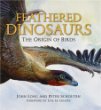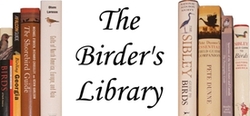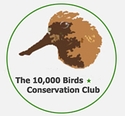I and the Bird #134: A Birder’s Library
One of the things I love most about birding is all of the books that go along with it. There are field guides, of course, but also guides to finding birds as well as ones for specific groups of birds. Travelogues take the reader to places they may never get to bird themselves, while other books explore the very nature of birding itself. The list goes on, and I love them all.
For this edition of I and the Bird, I’d like to explore some of the books that make up a birder’s library and show how they can be useful.
Before we start, I’d like to point out that the book links will direct you to my review of that title at The Birder’s Library, if I’ve done one. Otherwise, they will be Amazon affiliate links. If you purchase something after clicking on an affiliate link, I’ll get a small percentage, which I use to pay web hosting costs and, if I’m lucky, buy even more books to review. I’m not doing this to make money; I just think it’s a good way to raise awareness for some wonderful books and provide more information about them.
 The field guide is the cornerstone of any birding library. I really should say field guides, because you need more than one for your area. They all have particular strengths and weaknesses, but when they are used in conjunction you have a much better chance at making a positive identification. Some guides utilize paintings as illustrations while others use photographs. I’d recommend having at least one of each. It’s also a good idea to have a guide that includes all the likely (and not-so-likely) vagrants, like a Cuban Pewee in Florida.
The field guide is the cornerstone of any birding library. I really should say field guides, because you need more than one for your area. They all have particular strengths and weaknesses, but when they are used in conjunction you have a much better chance at making a positive identification. Some guides utilize paintings as illustrations while others use photographs. I’d recommend having at least one of each. It’s also a good idea to have a guide that includes all the likely (and not-so-likely) vagrants, like a Cuban Pewee in Florida.
But not even the most thorough field guide will include every bird that you could possibly see. You just never know what might show up. Thus, it’s a good idea for birders to also have field guides for other areas, especially those relatively nearby. Birders in the Southeast United States, for example, should have a guide to Caribbean birds handy, such as the new Birds of the West Indies.

Although a field guide’s primary purpose is to present information needed for identification, some of them also provide other natural history facts, like the graphs in Birds of Australia that indicate when each species breeds. That’s nice to know, as pelicans breeding on Lake Wyara is quite a sight.
 The majority of field guides in a birder’s library will be for, duh, birds. But that doesn’t mean we should ignore other organisms. A more general field guide could certainly be useful while on a beach in Costa Rica with birds, monkeys, and snakes.
The majority of field guides in a birder’s library will be for, duh, birds. But that doesn’t mean we should ignore other organisms. A more general field guide could certainly be useful while on a beach in Costa Rica with birds, monkeys, and snakes.
Some birds – immature hawks, for instance – can be very difficult to ID, and sometimes you need more help than a general field guide can provide. Thankfully, there are several advanced birding guides that focus especially on these birds.
 Sometimes you need something even more detailed and specific than advanced ID guides. There are certain groups of birds, like seabirds, that almost require a family-specific guide. Such a book would definitely be nice to have on a pelagic trip off of Panama.
Sometimes you need something even more detailed and specific than advanced ID guides. There are certain groups of birds, like seabirds, that almost require a family-specific guide. Such a book would definitely be nice to have on a pelagic trip off of Panama.
Family guides aren’t useful solely for identification; they can also be great sources on the biology and behavior of the group. If, for instance, you would like to see raptors in Costa Rica, it would be helpful to find out beforehand that most hawks there aren’t likely to be seen soaring, but rather inconspicuously perched.

Similarly, if you encounter something unusual, like bald mynas, a family guide may be able to help explain it (although in this case it didn’t, Starlings and Mynas didn’t shed any light on this situation, unfortunately).

Besides their myriad of uses, it can be a great pleasure just to flip through field and family guides. You can discover all kinds of interesting and cool-looking birds that way, such as one of my favorite groups – nightjars.

After a field guide, the first bird book I bought was a birdfinding guide for my state. After all, you need to know where the birds are in order to watch them! Even with the abundance of information now available online, a good birdfinding guide is still indispensible, and will point you toward some great birdwatching locations, like Charlie Elliott Wildlife Center in Georgia and California’s Vic Fazio Yolo Wildlife Area.
 For some people, birding is more than just a hobby. Reference books and those that synthesize research on specific topics can by handy when doing field work and pursuing a degree.
For some people, birding is more than just a hobby. Reference books and those that synthesize research on specific topics can by handy when doing field work and pursuing a degree. Birds do some weird things. A well-stocked library can help explain some of them, like why 38,000 puffins would want to live together.
Birds do some weird things. A well-stocked library can help explain some of them, like why 38,000 puffins would want to live together.
Learning about birds’ needs and habits during migration can help you find migrants and get some pictures of them.

Would you like to attract more birds to your yard? There are plenty of books that will help you landscape for birds, even hummingbirds in Texas.

Ever wonder what it’s like to hear like a bird? We’ll never know for sure, but The Singing Life of Birds will definitely help you better understand bird sounds.

Bird books can provide insight not only into what birds are and how they live, but also into where they came from. Perhaps a comparison between a heron and dinosaurs isn’t that much of a stretch.
 I love getting new field guides, discovering how birds fly, and exulting in a collection of fantastic bird photography. But perhaps more than any other kind of bird book, I enjoy those that explore what it means to be a birder.
I love getting new field guides, discovering how birds fly, and exulting in a collection of fantastic bird photography. But perhaps more than any other kind of bird book, I enjoy those that explore what it means to be a birder. Finally, not every item in a birder’s library need be a book. If it hasn’t already, software and other media is going to make a big impact in how we bird, even keeping track of the birds we observe.
Finally, not every item in a birder’s library need be a book. If it hasn’t already, software and other media is going to make a big impact in how we bird, even keeping track of the birds we observe.
As you can see, the books in your birding library can provide a wealth of information and hours (or even years in extreme cases) of entertainment. But there comes a point, even for me, when you just need to put down the book and go birding.
I hope you enjoyed this trip through a birder’s library as much as I enjoyed everyone’s submissions. The next edition of I and the Bird will be hosted on The Birder’s Report. In the meantime, if you’d like to find out more about the books I’ve mentioned or similar ones, or would like to suggest others, please let me know. I think it’s obvious that I love to discuss bird books.
Tags: books Posted in
Posted in 



